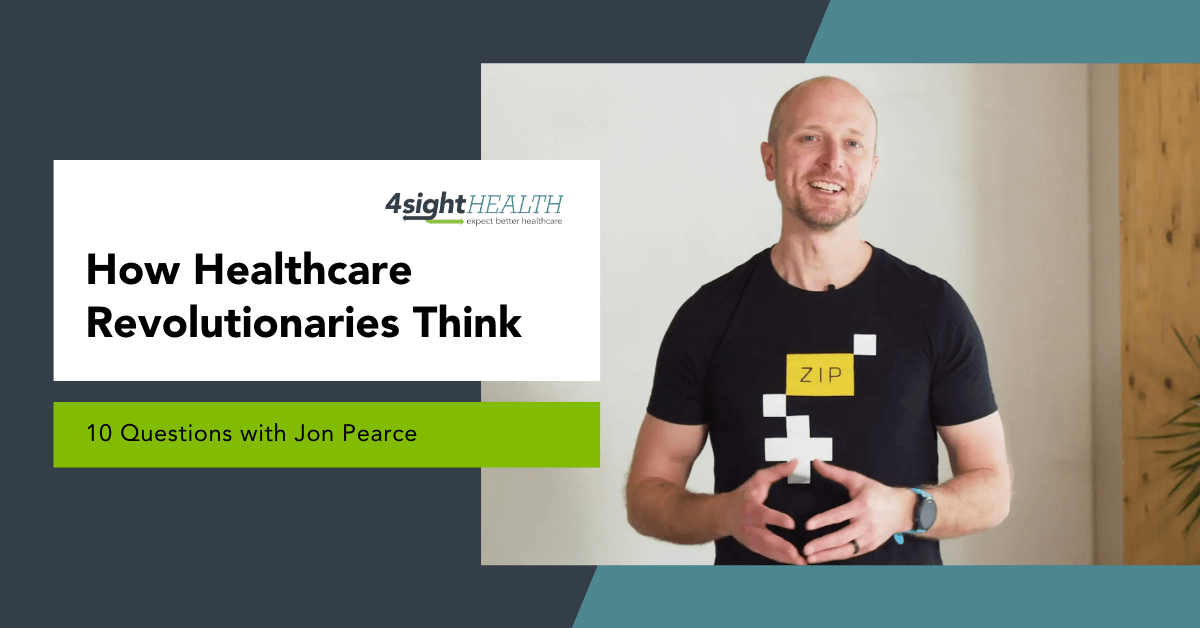April 15, 2021

How Healthcare Revolutionaries Think: 10 Questions with Jon Pearce
Welcome to the third installment of 4sight Health’s new monthly interview series, How Healthcare Revolutionaries Think. The interview series features healthcare instigators who believe that outcomes matter, customers count and value rules.
Are you paying royalties to Zipnosis, the Minneapolis-based telemedicine platform, and its Founder and CEO Jon Pearce? No? Have you ever used the phrase “digital front door” in your marketing copy to describe your new product, service or approach to care delivery? Yes? Well, you may want to open your digital checkbook app.
Pearce and his Zipnosis team coined the phrase seven years ago when they were trying to come up with a pithy and succinct way to describe to a prospective customer what Zipnosis does. Pearce trademarked the phrase “digital front door” in 2014. The rest, as they say, is trademark infringement history.
Pearce mentioned trademarking the phrase in passing when I interviewed him for this piece. To me, the moment captured his thought process — creative, strategic and competitive.
I picked Pearce’s brain about what he thinks of healthcare and how his opinions guide the direction of Zipnosis today and into the future with its recent acquisition by Bright Health.
1. Zipnosis has gone through several business model changes since you founded it in 2009. Walk me through those changes and why they happened?
Pearce: Yeah, there have been a lot of twists and turns along the way. In 2009, it was really clear to me that the smart phone was going to be the clinic of the future. We started as a direct-to-consumer primary-care provider, and we charged $25 for a virtual visit. It was a horrible business. The technology worked but looking back I think we made every mistake in the book in terms of distribution and business model. We were ahead of our time. Consumer adoption just wasn’t there a decade ago.
2. What were the next iterations of the company?
Pearce: We got a call from one of the big health systems here, and they didn’t want our brand, but they wanted to license our software and offer patients virtual visits under their own brand. During this next phase, we were doing both—our DTC business alongside our software-as-a-service model. Then we got more interest in the SaaS model from other health systems that wanted to white label their own virtual care options for patients, and we sunset the DTC business in 2014. Today 100 percent of our business is really building that digital front door for health systems that are licensing our technology.
3. How hard is it to change your business model mid-stream? What’s your advice for other healthcare entrepreneurs who may be off the mark initially?
Pearce: Well, when you have to let everyone go, and it’s just you, and you don’t have another paycheck, it’s actually pretty easy. You have to decide whether to give up or keep going. For me, it was something deep inside and hard coded that said, “Don’t give up. We’re not going to drop this now. Let’s see where this goes.” The business wasn’t working from an economic perspective. Everything else was. We were driving transaction costs down to zero. We were cutting clinic in-person visit times from 20 minutes to 90 seconds for virtual visits. We were achieving better clinical outcomes. We had great feedback from customers. All the core tenets of a high-functioning service were there. It just wasn’t the right time. But there was a lot there to build on if we kept going rather than throw away the business and walk away.
4. You were quoted in a local business journal in 2018 as saying telemedicine is dead. What did you mean by that, and do you still believe that even after the COVID-19 pandemic?
Pearce: Telemedicine, the way most providers and companies are practicing it today, is an antiquated business model. You’re basically replicating the in-person visit with an online visit, whether that’s done by phone or by computer. That was great during the pandemic when no one wanted to physically come in to see their doctor. But it’s not sustainable. The cost is still there, but you can’t charge as much. You can’t make any money from it. It’s a negative unit economic business model. I do think that model of telemedicine is dead. I’ll keep saying that every year until it happens.
5. If the telemedicine business model you’ve described is dead, what model of telemedicine is alive?
Pearce: There are alternative virtual care business models popping up that are absolutely going to eat the lunch of traditional telemedicine business models. They use technology. They are consumer-facing. But they’re embracing the powerful economics. They’re not trying to make money per visit per se. Instead, they’re giving away the visit as a commodity or using it to drive down costs in risk-sharing agreements. It almost becomes a loss leader. In more progressive D2C models, the virtual visit is embedded in a subscription model in which the customer pays a monthly fee, for example, to access a suite of other services. Those might be therapeutics, over-the-counter products, other types of health and wellness things. The virtual visit is a loss leader to get you in for other services that the company can make a bigger margin on. It’s the same reason grocery stores have pharmacies. You go in for milk and walk out with a prescription. Or go to the pharmacy and walk out with milk.
6. Speaking of subscription models and monthly fees, let’s talk about direct primary care, which relies on those models and fees for revenue. Is direct primary care dead or alive?
Pearce: Obviously, I’m biased here, so take my answer for what it’s worth. I love direct primary care when it’s coupled with virtual-first technology. That creates a much more efficient care-delivery model. It keeps routine clinical work time as minimal as possible by letting it happen quickly and conveniently via technology, whether that’s phone, text, email, computer, whatever. That leaves the in-person visit for the more important and necessary conversations between doctors and patients. Virtual helps keep operating costs down so these practices don’t lose their shirts. You’re also eliminating health insurers as middlemen because patients pay a monthly fee directly out of pocket. That also reduces operating costs for the practice. So, I think direct primary care is very much alive with a virtual care component.
7. If I’m a traditional primary-care physician, what can I do to stay relevant with my patients when everything around me is changing?
Pearce: The biggest barrier to staying relevant was the adoption of virtual care. But COVID changed that because it forced doctors to try it. And it turned out not to be as awful as they thought. The tools today are much more intuitive and much easier to integrate into your practice then they were eight, 10 years ago. Doctors said, “Hey, this could actually work out pretty well for us.” They’re finally connecting with their customers in a way that their customers have literally been begging them to do for years. When a traditional primary-care physician offers that virtual consumer experience, their patients love it. That’s how they stay relevant.
8. How does Zipnosis stay relevant? What’s the biggest threat to your business model now?
Pearce: It’s not technology. We’ve taken the position that we’re mode-agnostic. We connect whatever you want to connect or whatever new technology comes along through our platform. The biggest threat to Zipnosis is fee-for-service medicine and whether it continues to own the narrative. FFS marginalizes efficient care-delivery models, making it hard for them to flourish. If you lower your costs, you can’t charge as much, and your revenue goes down. Value-based risk-sharing payment models are our sweet spot because efficient care models deliver more for less. We’re not there as an industry yet because the status quo continues to have a FFS mindset.
9. I think a lot of people share that concern. What opinion do you have about healthcare that you think should be wider known?
Pearce: I think a lot of people believe this, but I don’t think we hear it enough. There is absolutely no reason to have a health insurer in the middle of healthcare. There just isn’t.
Technology is changing the roles of everyone in the traditional healthcare equation, but the equation isn’t changing. Patients are becoming their own doctors with consumer genetic testing, wearable health trackers, mobile biometric apps and home medical monitoring equipment. That’s changing the role of doctors from data collectors to data interpreters. They’re more coach than player.
There’s no longer a need for an insurer to be in the middle of that new relationship. They may have a role, but it’s not the same role as they have now.
10. What innovation do you think is the most over-hyped or exaggerated in healthcare?
Pearce: That list is pretty long. But I’d put interoperability at the top of it. Interoperability definitely is over-hyped. All this talk about data democratization is just that, talk. It’s over-hyped in two ways.
First, there are a lot of providers and vendors who say they’re interoperable, but they’re not. We still have a highly fragmented healthcare information system across the industry. Second, if they are interoperable, it’s just a dodge for not putting patients in charge of their own health data. All of these systems were designed for providers and payers, not patients. Providers and payers can share data, but patients can’t. You don’t need to be interoperable if patients are the source of their own data and control their own data. The data should flow where patients want it to go. Then the issue of interoperability goes away.
Let’s hope that healthcare revolutionaries like Jon Pearce never go away and keep agitating for a truly customer-focused healthcare system in the U.S. 4sight Health would like to thank Jon for sharing his story and insights with our audience. Please think of him every time you say, “digital front door.”
Jon Pearce, Zipnosis co-founder and CEO
If you ask Zipnosis CEO Jon Pearce what his superpower is, he will tell you it is to “have a vision, articulate it, and then inspire others around it.” It was that vision that led him to co-found Zipnosis in 2009 under the idea that there had to be a better, more consumer-centric way to deliver healthcare. Since 2009 Zipnosis has continued to be a catalyst in driving the healthcare industry forward, working with healthcare leaders across the country to integrate technology into care delivery.
Prior to founding Zipnosis Jon got his undergrad in Russian language and Computer Science from St. Olaf College. In 2000 he began working at healthcare start-up ProVation Medical until it was acquired by Wolters Kluwer in 2006 for over $100M. It was during his time studying for an MBA at the Carlson School of Management that his vision for Zipnosis took hold, and the rest is company history. Rain or shine (or snow, he is a Minnesota resident after all), you can find Jon running, tickling the ivories, and laughing until it hurts with his son and wife.
Read More Healthcare Revolutionary Interviews
- Gaurov Dayal, M.D., Everside Health, February, 2021
- Thompson Aderinkomi, Nice Health March, 2021
- Robert Pearl, MD (coming soon)
- Kurt Waltenbaugh, Carrot Health (coming soon)





